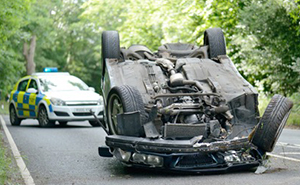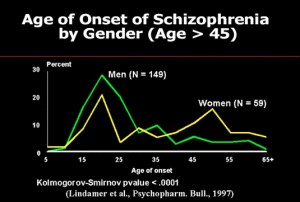Schizophrenia and Dangerous Behaviour
Schizophrenia and Dangerous Behaviour
It is one of the commonest and most enduring myths around schizophrenia that all people suffering from this condition are violent. In public opinion schizophrenia is most often associated with violence than with any other type of disordered behaviour.
This is undoubtedly fed and reinforced by rancorous and ill-informed media reporting of the subject. Articles and current affairs programmes that focus on violence in schizophrenia whilst ignoring all of the other features of this complex condition, particularly the high suicide rate and telling us very little about the illness in general, are sadly all too common. A study carried out in 1994 of the British news media found that stories about violence by people with schizophrenia outweighed sympathetic news stories about the condition by about four to one.11
Sadly this subject is one that many people engaged in the caring professions feel particularly uncomfortable discussing. Dangerous behaviour is very often seen by them as a failure on the part of the doctors rather than as a feature of a society which undervalues people with mental illness and under-funds mental health services. In addition, at times of tragedy, they are often faced with hostile reporting by the media which seeks to point fingers of blame at the doctors rather than at society’s attitudes to treating mental illness.

American Psychiatrist E. Fuller Torrey has said that some mental health workers believe that not discussing dangerousness in schizophrenia will help fight stigma. (Image: Andrii IMath)
Perhaps also some health workers have fallen into the trap of being reluctant to discuss the problem of violence in schizophrenia in part, as the eminent US psychiatrist Torrey argues, because of their eagerness to reduce the stigma associated with the condition.4
Are people with schizophrenia dangerous?
Whilst the myth that all people with schizophrenia are violent is not founded in the evidence, it is the case that people living with schizophrenia are more at risk of dangerous behaviour such as suicide or violence while they are poorly.
Thankfully violent behaviour is comparatively rare. Most people with schizophrenia are never violent and indeed do not display any dangerous behaviour. However a small number do become violent when they are suffering from the acute symptoms of psychosis because of the influence of the hallucinations and delusions on their thinking. Studies have found that in cases of dangerousness, it is the delusions that are usually more influential in causing the dangerous behaviour than the hallucinations. However tragically it is also the case that many people with schizophrenia harm themselves and very often they succeed in killing themselves.
Schizophrenia and suicide

Schizophrenia kills as many people in the UK as traffic collisions. (Image: Shutterstock)
About 280,000 people are currently being treated for schizophrenia in the UK. Of these about 10% will die by their own hand within ten years of their diagnosis13. With an annual death toll of between 800 and 1,800 in the UK alone suicide is a major cause of premature death amongst people with schizophrenia and on a par with road deaths.17
Schizophrenia and violence
Prior to 1980 the accepted view amongst most professionals was that people with schizophrenia were no more likely to become violent than sane people. However in recent years there has been a strong body of evidence that suggests that this earlier view may have been mistaken and that people living with schizophrenia are responsible for more aggressive and violent acts than people who do not suffer from the condition.5 Whilst current research evidence points sharply in this direction (indeed some researchers suggest that it points conclusively in this direction14) it still raises many unanswered questions as the various studies often use different methodologies.

If you have schizophrenia then using street drugs will increase your risk of dangerous behaviour fifteen fold. (Image: Axente Vlad on Shutterstock)
However, one key aspect of this condition that the modern research does tend to agree on is what most health workers know to be true, that co-morbidity with substance abuse is a clear predictor to violent behaviour. When a person with schizophrenia abuses alcohol or street drugs their risk of engaging in dangerous behaviour increases fifteen fold.5
Whilst suicide is by far the larger component of the total mortality figure for schizophrenia, the other part is the very much smaller but equally as tragic figure for homicide. Each year in the UK about 30 murders are committed by people living with schizophrenia. However, it is important to note that the number of attacks carried out by people with schizophrenia is a small part of the total of about 600 murders in the UK each year. In terms of the total number of homicides there are other risk factors at work which are much more influential. The risk factors for murder in the general population are being young, being male and being drunk.
Some estimates have put the incidence of violent behaviour amongst people with schizophrenia at around 10-15 %.2 Others have put the incidence of violent behaviour or threats of violent behaviour as high as 23%.3 How does this compare with other mental health issues? Well, studies have shown that people with schizophrenia alone are less at risk of violent behaviour than those with depression, bipolar disorder, personality disorders or substance abuse problems.5
A study carried out about 14 years ago found that around 11% of unlawful killings in the UK are committed by people suffering with schizophrenia but that the number was declining by about 3% per year.6 More recent work has found that about 30 of the 600 murders in the UK each year are committed by people with schizophrenia. So the average probably lies somewhere between 5 and 10%.7

Schizophrenia is first diagnosed mainly in young people between 16 and 25 years old.
The problem with these statistics however is that they are skewed by the age of the attacker. Schizophrenia tends to strike in late teens and early twenties and so most people suffering from the illness are young. It so happens that young people also make up the majority of violent offenders in the UK generally. So this begs the question: are young men with schizophrenia more likely to attack others than sane men of the same age and a definitive answer to that question is not easy to come by.10 In the same way the statistics are skewed heavily by the issue of substance abuse. We simply do not know what proportion of dangerous behaviour in schizophrenia is caused by psychotic thinking and how much is fuelled by alcohol or drug abuse.
At this point it is also worth a look at the issue of victimisation; that is how frequently people with schizophrenia become victims of violence themselves. Research shows that people living with schizophrenia and living in the community rather than in hospital are about 14 times more likely to be the victim of violent crime than to be the perpetrator of it and at considerably higher risk of being a victim than people who do not have schizophrenia.4 This could be due to the person with schizophrenia engaging in socially unusual behaviour which provokes an aggressive response in others or it could be due to them being targeted by predatory criminals who readily perceive their inherent vulnerability.
Who is at risk?
When a person with schizophrenia becomes violent the victim is usually someone from their own family or someone else close to them such as a carer. Attacks against strangers are extremely rare. When the attacker is female they will almost invariably attack their own children.8
Schizophrenia and sex
Another kind of behaviour that can be considered dangerous is sexually disinhibited behaviour. We consider it here because, although it is usually quite superficial in nature, it can be extremely distressing to those on the receiving end of it and it is likely to lead to the person with schizophrenia coming into contact with the criminal justice system where, given the nature of the offence, they are unlikely to receive sympathetic treatment.
Studies have shown that around 8% of people with schizophrenia will exhibit unusual overt sexual behaviour such as inappropriate sexual advances, disrobing or masturbating in public15. Sexually disinhibited behaviour is probably under-reported because it mainly occurs within the family context and families are often loathe to disclose it to professionals for fear that their loved one will be branded a sex offender and absorbed into the criminal system. It is not uncommon for young men with schizophrenia to develop a sexual attraction to their mother or sister or for people with schizophrenia to think that they have somehow become gay even though previously they were very happily heterosexual16.
However conversations with other sufferers have led this author to conclude that bizarre thoughts and ideas of a sexual nature affect all sufferers of schizophrenia. This is after all what we would expect. Schizophrenia affects the entire psyche including the sexuality and does not leave any part of it untouched. In conversation sufferers have described developing sexual attractions towards other family members, family pets and even inanimate objects such as household appliances! In this way, this aspect of schizophrenia illustrates superbly well the often extremely bizarre nature of psychotic thinking.
Remember also that schizophrenia is principally a condition of young people (three quarters of all diagnoses being made between ages 16 to 25), the time of life when the libido is at its peak and when both men and women are usually very sexually active. It is not therefore surprising for them to be troubled by bizarre sexual thoughts during psychotic episodes.
Other types of dangerous behaviour
Although cases of violence by people with schizophrenia and to a lesser extent suicide are well publicised by the media, dangerous behaviour may take a number of other forms. For instance a person with schizophrenia may become convinced that they can fly and will jump off a high building. They do not intend to kill themselves in doing so but their behaviour nonetheless will result in death or serious injury. Or dangerous behaviour could be as simple as crossing the road without looking because they believe that they are invulnerable and are being protected by angels.12
What can be done about dangerous behaviour?
The problem of dangerous behaviour in schizophrenia is all the more tragic when we accept that dangerous behaviour, both suicide and violence, by people suffering from schizophrenia is almost always predictable. There are three risk factors which, from years of study, we know will predict dangerous behaviour in schizophrenia.1 The first of these is a previous history of dangerous behaviour or threats of such behaviour. If you have attempted suicide before, then there is a good chance that it will happen again. Similarly, threats of suicide or violence should always be taken seriously by carers and practitioners.
The second risk factor is a history of drug or alcohol abuse. This is no great surprise. Being drunk or off your head on street drugs puts you at risk of dangerous behaviour whether you suffer from schizophrenia or not.
The third risk factor is compliance with or as we prefer to say nowadays adherence to the medication regime. Time after time when we hear of some tragic death in the news we are told that the person deteriorated after they stopped taking their medication.
These two risk factors tend to go hand in hand. When a person stops taking their anti-psychotic medicine they will very often resort to alcohol or street drugs in its place. Carers and professionals must always be aware that whatever problems are experienced with taking antipsychotics they remain the first line of defence against dangerous behaviour for people living with schizophrenia.
Some studies have found that some of the newer second generation of “atypical” antipsychotics particularly Clozapine, Risperidone and Olanzopine are more effective at reducing violent behaviour than the older “typicals”. Similarly some types of cognitive behavioural therapy have been found effective in reducing violent behaviour.4
It is vital that professionals caring for people with schizophrenia take all of the warning signs seriously and that carers are listened to when they try to get help for their loved ones. These risk factors are key and should be at the forefront of every sufferer’s recovery strategy and every doctor’s care plan.
Could we do more to avoid dangerous behaviour?
In recent years a considerable amount of work has been done on refining our approach to risk assessment and there are now a number of risk assessment tools available to psychiatrists which use factors such as drug and alcohol abuse, previous history of dangerousness, the person’s degree of insight into their condition and their level of occupation. These tools have had varying amounts of success and the likelihood of predicting dangerous behaviour using these tools, without at the same time labelling as potentially dangerous many people who present no risk at all, remains low. 2
But as we have said above monitoring and controlling the three core predictors to dangerous behaviour should give us the means to reduce the incidence of dangerousness without recourse to complex risk assessment tools provided, and this is key, that society is willing to fund the additional costs involved.
However it is not simply a question of funding. It is also necessary for mental health workers, particularly those in the voluntary sector, to give people living with schizophrenia clear and unequivocal messages about the need for adherence with medication and abstinence from substance abuse12.
It may be that we need to develop better diagnostic and therapeutic tools to help us control dangerous behaviour. However little will change until the mental health service has the resources it needs to adequately supervise those at risk and for that to happen there must be a sea change in our society’s attitudes to resourcing mental illness in general and schizophrenia in particular.
References
1. Torrey E, 2001, Surviving Schizophrenia , Quill, P308.
2. Fazel S, Reinharth J, Serper M, Singh J, 2011, Structured Assessment of Violence Risk in Schizophrenia and Other Psychiatric Disorders: A Systematic Review of the Validity, Reliability, and Item Content of 10 Available Instruments, Published in Schizophrenia Bulletin September 2011.
3. Rollin H, 1980, Schizophrenia at Home, Published in Coping with Schizophrenia, Burnett Books. P23.
4. Carpenter W, Wehring H, 2011, Violence and Schizophrenia, Published in Schizophrenia Bulletin September 2011.l.
5. Buchanan A, Fahy T, Walsh E, 2002, Violence and schizophrenia: examining the evidence, Published in the British Journal of Psychiatry.
6. Gunn J, Taylor P, 1999, Homicides by people with mental illness, Myth and Reality. Published in the British Journal of Psychiatry.
7. Reveley A, 2006, Your Guide to Schizophrenia, Hodder Arnold. P16.
8. Leff J et al, 1997, Care in the Community: Illusion or Reality, John Wiley. P176.
9. Cutting J and Charlish A, 1995, Schizophrenia, Thorsons, P 192.
10. Leff J, 2001, The Unbalanced Mind, Phoenix, P123.
11. Warner R, The Environment of Schizophrenia, Brunner Routledge, P8.
12. Author’s personal experiences.
13. Torrey E, 2001, Surviving Schizophrenia, Quill, p130.
14. Hodgins S, 2008, Violent Behaviour Amongst people with schizophrenia: a Framework for Investigations of Causes, and Effective Treatment and Prevention.
15. Rollin H, 1980, Coping with Schizophrenia, Burnett Books.
16. Howe G, Serious Mental Illness a Family Affair, Sheldon Press, 1997.
17. Accurate figures of deaths by suicide amongst schizophrenics are difficult to derive. However by drawing on various UK and US sources a mortality rate due to suicide alone of 300 to 600 per 100,000 per year seems to be a good and close approximation.







